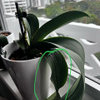Janet Craig Draecana - Brown Spots! Help!
A few weeks ago, I brought home a beautiful Janet Craig draecana from Home Depot. It had a couple small brown spots on its leaves (brown, brittle spots). The woman working in the nursery seemed very knowledgeable and said the spots are caused from getting water on the leaves.
I've been extremely careful when watering to avoid getting any water on the leaves, and yet the plant is rapidly deteriorating with additional brown spots.
{{gwi:80362}}
I've also been very minimal with watering as it was saturated when we brought it home and I don't want to overwater.
What the heck is going on and how do I fix it?
Comments (23)
birdsnblooms
13 years agoPumpkin. The woman at HD had no idea what she was talking about..The spots on your Dracaena leaves, are NOT water spots. They don't even look like residue from any liquid, including chemicals.
Are the brown spots the same as those on the tips of leaves or a different spot altogether?
Can they be scraped off?I'm familiar with HD's employee handiwork. I wouldn't doubt the soil was excessively dry. Plants were probably hosed the day you happened to shop.
When D. JC soil dries for prolonged periods, leaf tips brown, a crispy brown. Was your Dracaeana in the green house or store?
A second possibility is over-watering. With HD, one never knows. Over-watering can cause brown spots and tips, too.
You have a few options. 1. Wait a couple weeks, w/o adding more water, to see if spotting spreads.
2. Remove Dracaena from its pot, toss out old soil, add fresh, well-draining soil. 3. Cut back to the lowest leaf. Your plant will continue growing. 4. If you saved the receipt, take back to HD. Their policy is, if within one year a plant has problems or dies, you can either get a refund or exchange.
Were there any other Dracaenas w/o spots?When we buy a new plant, it should be in good health. It doesn't matter if it cost 1.00 or 20.00.
Dracaenas dislike Chlorine and Floride. In the future, either use distilled water, or better yet, save an old, cleaned milk container, fill with tap water. Water 24-48 hours later. Water will be room temp, Chlorine and Floride will evaporate.
Whether you keep this Dracaena or exchange, water when soil feels semi-dry.
Also, keep out of direct sun. The Janet Craig does well in bright light. Direct summer sun will cause sunburn.I hope you get this problem resolved..Toni
Related Professionals
Cary Landscape Architects & Landscape Designers · Hyattsville Landscape Architects & Landscape Designers · Walnut Landscape Architects & Landscape Designers · Wilmington Landscape Contractors · Bridgeview Landscape Contractors · Bristol Landscape Contractors · Fishers Landscape Contractors · Fountain Valley Landscape Contractors · Golden Landscape Contractors · Hollywood Landscape Contractors · Lorain Landscape Contractors · Norristown Landscape Contractors · Wailuku Landscape Contractors · Maple Heights Landscape Contractors · Hillcrest Heights HandymanJoe1980
13 years agoI find that a lot of plants are sensitive to tap water, especially if you have a water softener. I collect clean rain water, and by clean I mean NOT off of the roof via rain barrels. I set an old resin patio table top, with the umbrella hole, on top of a 5 gallon bucket. It then gets run through a coffee filter to screen the dirt & bugs out, and stored in a 55g plastic barrel. I usually go into winter with the 55g barrel full, and by spring, it's almost empty. My plants never got any wierd brown leaf spots or tips ever since I started using rain water.
birdsnblooms
13 years agoHowdy Jane. At first glance, the spots on Pumpkins Dracaena reminded me of a trail, insects called Leaf Miners leave on citrus foliage. But that's impossible..lol.
Do you mean it looks like a chemical fell or was sprayed on her plant?Joe, I'm so proud of you..you ARE dedicated. Collecting rain water..How much rain did you get per barrel?
I tried the same with rain and snow, but after a heavy T-Storm, and snow melted, (different seasons) all that accumulated were a couple inches, if that..loljane__ny
13 years agoHi Toni and Joe, again. Toni, I thought possibly something in Home Depot which was chemical spotted the leaves. Who knows, they could have splashed bleach or detergent.
Joe, I like your method of collecting rain water. I collect also, but never thought about the umbrella hole. What a great idea. I put buckets, bowls, cut soda bottles, etc. out on the deck to collect rain but half the time, the wind blow them around.
I had a big rain-barrel, in my old house which would collect enough rain to water my container plants on my deck. Of course, it froze in winter, but was great all summer. It had a screen to keep out dirt and bugs. I gave it away when we moved. Now I regret that.
Orchids do not like chemicals in tap water. They don't like high mineral content, which our well water has. I installed a Reverse Osmosis filter under my kitchen sink. It only generates approx. 3 gallons over a 2 hr. period, so I continue to collect rain water.
Toni, I know what you mean about snow. I tried that once also. What a waste of time that was.
Jane
norma_2006
13 years agoI need to add vinegar to my water to soften it. Then it doesn't cause water spots.(which leaves white spots on the leaves when it dries) An old grower taught me this trick. All growers in Calif. and doing this now. Also another experienced commercial grower waters his green house plants at night so the sun doesn't damage them after he waters by drying too fast. The professional growers have so many tricks. I water my San. house plants with tepid water by hand, and from the bottom. I would take it out in the Summer if I could lift it to be washed off. This one has huge leaves. (5" x 45"long) Norma
pumpkin2010
Original Author13 years agoThanks for the replies, everyone.
The plant was located in the store (not outside in the garden area) and they all seemed to have a few brown spots. The spots cannot be rubbed off - they're areas of the leaves which have turned thin and brittle (dead?)and the spots on the inner areas do eventually turn brown, the same as the spots on the tips of the leaves.
As I haven't watered much at all (due to the saturation when it came home with me), the soil feels quite dry now. If I give it another couple weeks, will I be doing any more harm? Will it obviously wilt to let me know it's thirsty, or could I potentially kill the thing by withholding water at this point?
I'm seriously considering taking it back, though I doubt I have the receipt. =(
tapla (mid-Michigan, USDA z5b-6a)
13 years agoHi, Pumpkin.
I think the proposed cause of the issue was probably offered in error, but horticulturalists often use the term 'water spots' to refer to the evidence/symptoms left behind by oedema, which is the localized bursting of cells in various tissue that leaves water-soaked spots in the foliage that eventually turns corky and brown. It results from excess turgidity (water pressure in the plant that is so high it actually causes cells to rupture), the primary cause of which is over-watering/lack of oxygen in the root zone. It can be further exacerbated by extended periods of low light and/or high humidity.
I'm pretty sure the spots are not fungal in nature because most fungal infections exhibit a 'halo effect' surrounding the infection site.
The blemishes themselves cannot be fixed, but you can take steps to stop them from happening again. If you're interested, we can get into more detail.
Al
birdsnblooms
13 years agoJane..How much rain accumulated in the barrel? Especially blocked by a screen...it must have taken days and heavy rain.
Oh yeah, snow collecting is a job and a half, makes less than an inch of water if lucky..lol...Although many people would disagree, I've placed snow directly on top of soil. The cold can cause root shock, but it didn't seem to harm them. However, I only added snow on plants that were replaceable, 'as an experiment,' like Pothos and a few others. I Don't recommend it.Norma..We're advised, 'never water after dark.' Do you know if he waters succulents at night, too? I'm assuming, he lives in a part of CA where temps don't drop too low at night??
What 'Giant' Sans species do you have? Do you have a photo?
I belive in many of the old-ways. Many tricks that work.
Pumpkin. Before watering or not, check the soil. Carefully, insert a stick deep in the soil. If the stick comes out wet or muddy, bottom soil is still wet. Wait a few days and recheck.
If the stick comes out dry, then it needs a drink.Lifting the pot is another way to test if soil is dry, though not as thorough. Soil lightens when dry, heavier when moist/wet.
Did you repot? If not, does the container have a bar code? Even if you can't find the receipt, all they have to do is scan..
If you're a regular shopper, they might exchange or refund..afterall, stores do not like losing customers.One more thing. You said, their plants all seem to have brown spots. If their plants have problems, perhaps you should find a different plant shop??? Toni
pumpkin2010
Original Author13 years agoI did not repot the plant.
Al - yes please, details are welcome on how I can avoid further spots/salvage the plant.
Toni, I know =( It was an impulse purchase.
tapla (mid-Michigan, USDA z5b-6a)
13 years agoIn most cases, plant health is most affected by the relationship between your soil and watering habits. This is especially true if light requirements are reasonably close to what the plant prefers. Ideally, you want to be able to water thoroughly, so a good portion of the water you apply flushes through the soil and out the drain, carrying accumulating salts from your tap water and fertilizer solution with it. Some soils are so water-retentive that they won't allow you to water this way without incurring the symptoms you're looking at on your plant. You're left with the decision to either water in sips and suffer the effects of accumulating salts, or water copiously to flush the soil and risk root rot.
The best remedy is to adopt a soil that offers better aeration and drainage, which eliminates both problems and provides a much healthier root environment for ALL of your plants. If you decide you want to pursue that avenue, I can help you with your course.
For the immediate, I would be thinking of using a wick to help drain your plant after watering. I'm assuming it has a drain hole? It's as easy as pushing a strand of absorbent material through the drain hole and letting it dangle below the pot after you water. If you can manage it, drill or melt a hole (if the pot is plastic) through the edge of the bottom of the pot & put your wick there. Then, when you water, tip the pot at a 45* angle so the wick is at the lowest point, which will drain a lot of extra water. In fact, when using heavy soils it's always a good thing to tip your pots after watering because this temporarily reduces the amount of soil in the zone that perched water occupies. Water will be forced out of the pot because you tipped it. When it stops draining after tipping, and when the wick stops dripping, just return it to it's saucer or normal spot.
If you have other questions or interest in getting your plants into a soil that will make your job much easier and provide you with a much wider margin for error, just let me know & I'll be glad to help.
Al
tondajoe
12 years agoHello, im am wishing i may get a bit of help from the experts. I have what im pretty sure is a janet craig, i've had it for over 8yrs..i recently figured out what it was (or think it is) with in the last year, also in the past year i have trimmed it down and created "babies" or cuttings. Just the past few days, ive noticed that on a few stalks the new growth has brown spots and seems unhappy. I will say it has not been repotted since i brought it to my office about 7yrs ago. so my question is, could this be a depleated soil issue? or maybe something a bit deeper? im sorry this post is so wordy but im trying to give the most info i can think of, i will get pictures posted as soon as i get to work in the am. i would like any and all help as i really hate to "lay to rest" any plant as i take pride in my ability to grow and care for them, im sure everyone may agree, you learn something new every day :) **sorry for any spelling mistakes, new laptop..still working on how to use it!**
thanks to all, Tonda
ronalawn82
12 years agopumpkin2010, ".....as it was saturated when we brought it home". The brown spots are probably due to this condition. If you do not like how it detracts from the looks, you can either remove the leaves altogether, or else trim off the brown; but try to maintain the shape and proportion of the leaves.
Allow the mixture to dry out all the way to the bottom of the mix before you water next.
Observe keenly and regularly, the growing area. Look for any sign of browning on surface or edges of the young leaves. Sniff for any malodor and if you detect any, jerk the 'spindle' of young leaves right out of the plant. (I have never seen a 'JC' recover from this "top rot"; but I have not seen everything)
It will send out a new shoot from a lower bud.tapla (mid-Michigan, USDA z5b-6a)
12 years agoTonda - most problems related to spoiled foliage originate in a tight triangle that includes soil choice, watering habits, and the level of dissolved solids (salts) in the soil. When you mention the fact that the problem is occurring in new foliage, it tips the balance toward increased possibility that it may be a nutritional issue, and more specifically one of the micro-nutrients or possibly Ca.
Pictures would be helpful, and more information essential. The answers to the following questions would be very helpful. When you water, do you water so at least 10-20% of the total volume of water applied exits the pot, or do you flush the soil thoroughly and regularly? What are you fertilizing with? how much? how often? what strength? When you water, is the soil still moist or do you allow it to become quite dry before watering again?
In terms of nutrition, there really is no such thing as a depleted soil. There are soils that have structurally collapsed, but because the grower is responsible for the plant's nutritional needs, soils don't become depleted. If a grower depends on the soil to satisfy the plant's nutritional needs, there is a mistake in the offing. I often grow plants in soils that are totally inert; that is to say they supply NO nutrition whatsoever, and plants are perfectly happy as long as I hold up my end when it comes to fertilizing.
I have found that concentrating on cultural considerations that keep roots happy generally results in a healthy plant and good growth above ground with no additional effort. Foliage problems, even those related to insects and disease are usually a direct result or can be traced indirectly to the effects of a compromised root system.
Without question, your plant needs to be repotted, which is different than simply potting up. I know you said the plant hasn't been potted up for 7 years, but have you bumped it up to a larger pot during that time? Now isn't a good time to repot, but after you've answered the questions, assuming you want to, perhaps a plan can be put in place that will get your plant back on track.
Al
tapla (mid-Michigan, USDA z5b-6a)
12 years agoTonda - Sorry, in the last paragraph, I meant to say, "I know you said the plant hasn't been repotted for 7 years, but have you bumped it up to a larger pot during that time?"
Al
tondajoe
12 years agotapla, thanks for the reply. I do water about once a week, most times the soil is dry at least a finger length down. I did notice today that my roots are circling the bottom of the saucer! so a repot and most likely a bigger pot seems to be in great need.as for any fertalizer, we fertalize about once a month with miracle grow (we meaning my co-worker and I-who seem to take care of everyone elses plants as well as our own!)
Im not sure what you mean by "flush the soil"{{gwi:80363}}
{{gwi:80365}}
tondajoe
12 years ago**sorry** i attempted to post pictures directly to the forum! Lets try this instead
this should be a link to my flickr account.i sure hope it works!
Tonda
Here is a link that might be useful: http://www.flickr.com/photos/38518539@N00/sets/72157628919822511/
tapla (mid-Michigan, USDA z5b-6a)
12 years agoIf you don't water copiously each time you water so plenty of the water you applied (at least 10-20%) exits the drain hole, or make the effort to flush the soil thoroughly on a regular basis, all the salts dissolved in tap water and those in fertilizer solutions remain in the soil. Eventually, this can have the same effect on roots that curing salt has on ham or bacon - it can literally pull water OUT of plant cells instead of allowing water to freely pass INTO cells. This is decidedly bad for the plant & visual symptoms usually occur as spoiled foliage, more prevalent in winter when humidity levels are low and the effects of a compromised root system are manifest.
If indeed it's been 7 years without a repot, I would also suspect deficiencies of Ca and Mg might be playing a part - especially Mg because it's much more soluble than Ca.
I'll give a brief synopsis of what I would do for now. If you decide you think you'd like to follow my direction, I'll be much more specific. I would flush the soil now - thoroughly and repeatedly. I would unpot the plant & inspect for compromised (rotted) roots. Allow the plant to dry down (out of the pot) and then pot up a pot size. In summer (winter and early spring are poor times to repot), I would do a full repot into a durable, well-aerated, and and fast-draining soil, and cut the plant back. For now, after you flush the soil, I would sprinkle a teaspoon of gypsum on the soil and use a little Epsom salts whenever you fertilize (details later). Sometime between now and repot time in summer, I suggest you acquire some Foliage-Pro 9-3-6 fertilizer, which HAS Ca and Mg in it.
.... ball's in your court.
Al
tondajoe
12 years agoAl, i will be taking my baby home tonight to start your process. I can control the environment a bit better at home than at work.
As for the gypsum on the soil, how often should i do that? Or is that a one time thing? Should i Epsom salt each and every time i fertilize? I thought i heard at one time that Epsom salt kinda acts as a purifier to the soil...did i hear wrong? (I have actually never used it)Thanks for all your help! I deeply appreciate it!
Tonda
tapla (mid-Michigan, USDA z5b-6a)
12 years agoHere is my reasoning: Since you haven't repotted in 7 years, it's a virtual certainty that the original fraction of Ca and Mg that would have been in the lime incorporated into the soil when it was made is depleted, leaving the break-down of soil particles and your tap water as the only source of Ca and Mg. Abnormal new growth is often a sign of a deficiency of one of the immobile nutrients, which would most likely be a micro-nutrient or Ca. Since all the micro-nutrients likely to be deficient in container media are included in your regular applications of MG fertilizer, that leaves Ca/Mg as potential problems. We can guard against that issue w/o contributing significantly to the level of dissolved solids in the soil, so let's do that right after we flush the soil. If you need a little gypsum, let me know & I'll mail it - that way you won't have to buy 10 (if you can find a small pkg) or 50 lbs.
Epsom salts doesn't purify the soil. It's a salt, and if not used judiciously can be a limiting factor. Those that apply Epsom salts or iron supplements in a quest for greener plants are more often doing harm than good, because anything in the soil solution not needed has the potential to be limiting. When 'treating' your plants with elements or compounds aimed at providing a single nutrient, it's wise to make sure you understand the implications, the ripple effect, of actions taken.
Your first step should be to flush the soil with room temp water. Move the plant to a shower/tub/near a drain .... and saturate the soil. Wait 10 minutes and then pour a volume of water equal to the volume of the container the plant is in, through the soil repeatedly. Do this at least 5-10 times, the more the better. Tilt the container at a 45* angle after flushing. This changes the shape of the saturated layer of soil to an inverted triangle and forces much of the excess water from the pot. After it stops draining, unpot the plant & set it on newspaper until the wet spot is no longer expanding. This removes the rest of the excess water from the soil. Inspect the roots. If they are black/slimy/sour-smelling, you'll need to repot. This entails removing old soil, pruning roots back to sound tissue, and repotting into the same size or a smaller container, depending on soil choice and what fraction of roots you remove. Hopefully, you can avoid repotting at this time because winter and early spring are poor times to repot most houseplants because their energy levels are lowest in late winter & early spring.
Are you with me so far?
Al
birdsnblooms
12 years agoTonda. Other than brown inside the crown/vase, 'top of leaves,' I see very little brown. Maybe I'm missing something?
For the time being, inspect the crown thoroughly. I don't want to frighten you, but plants with vases 'can' attract insects so it never hurts to check.
Two insects to look for are Mealy, 'white, cottony masses,' and Spider Mites, 'minute, sometimes very difficult to spot, various colored spots. Mites weave fine webbing.'
When you have time, check inside the crown. Look for webbing and/or white masses.
Using a large cotton ball or paper towel, swipe, inside the crown.
If insects are present, the paper towel/cotton ball will have what looks like dirt particles, possibly sticky. If without insects, the cotton ball should come out clean.There are other ways of checking for insects but for the time being give the paper towel/cotton ball test a try.
Toni
tondajoe
12 years agoAl: So far so good, i did bring her home tonight and will be starting the process per your instructsions. I always thought that epsom salt to "purify soil" seemed kinda off which is a big part of the reason i had never used it, but nobody ever corrected that therory...i know now. As for the gypsum, thank you for the offer that is way too kind of you, but deb at my work (anther plant enthusist) is dropping some by tonight.
Toni: unfortunatly i know all too much about the dreaded mealy bug...they have taken a hoya of mine and i am currently at war with them now with a differnt hoya (no worries, it is in quarintine untill i can win!) The first thing i did was check for any type of plant hungury bugs and have not found any.
Okay, im off to start the flushing process!
tapla (mid-Michigan, USDA z5b-6a)
12 years agoI'm sure we're all pulling for you. ;-) Good luck ....... and let us know how you fare.
What you're undertaking today will serve to help guard the plant tomorrow, against the possibility of continued damage due to accumulating solutes in the soil. I only mentioned that because it won't repair existing damage.
Al



















jane__ny